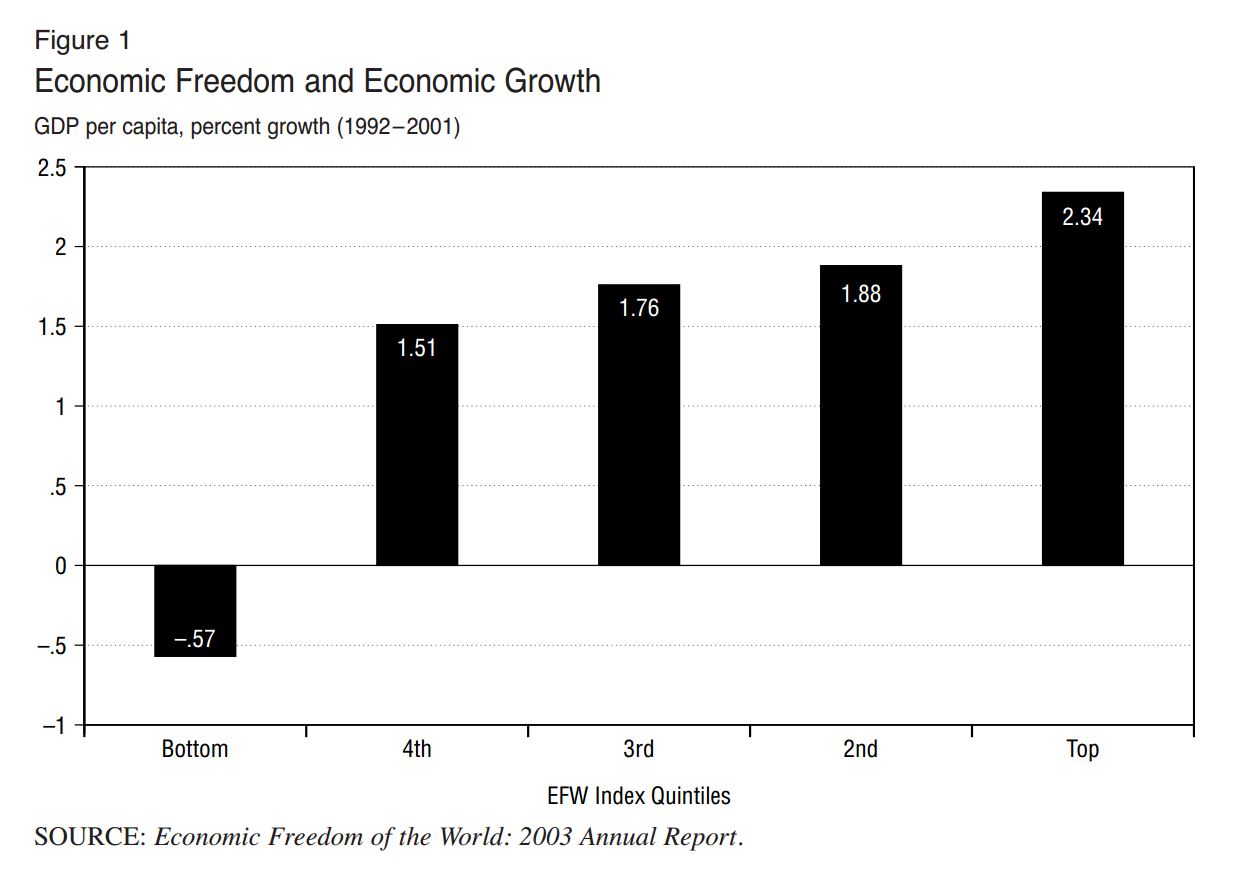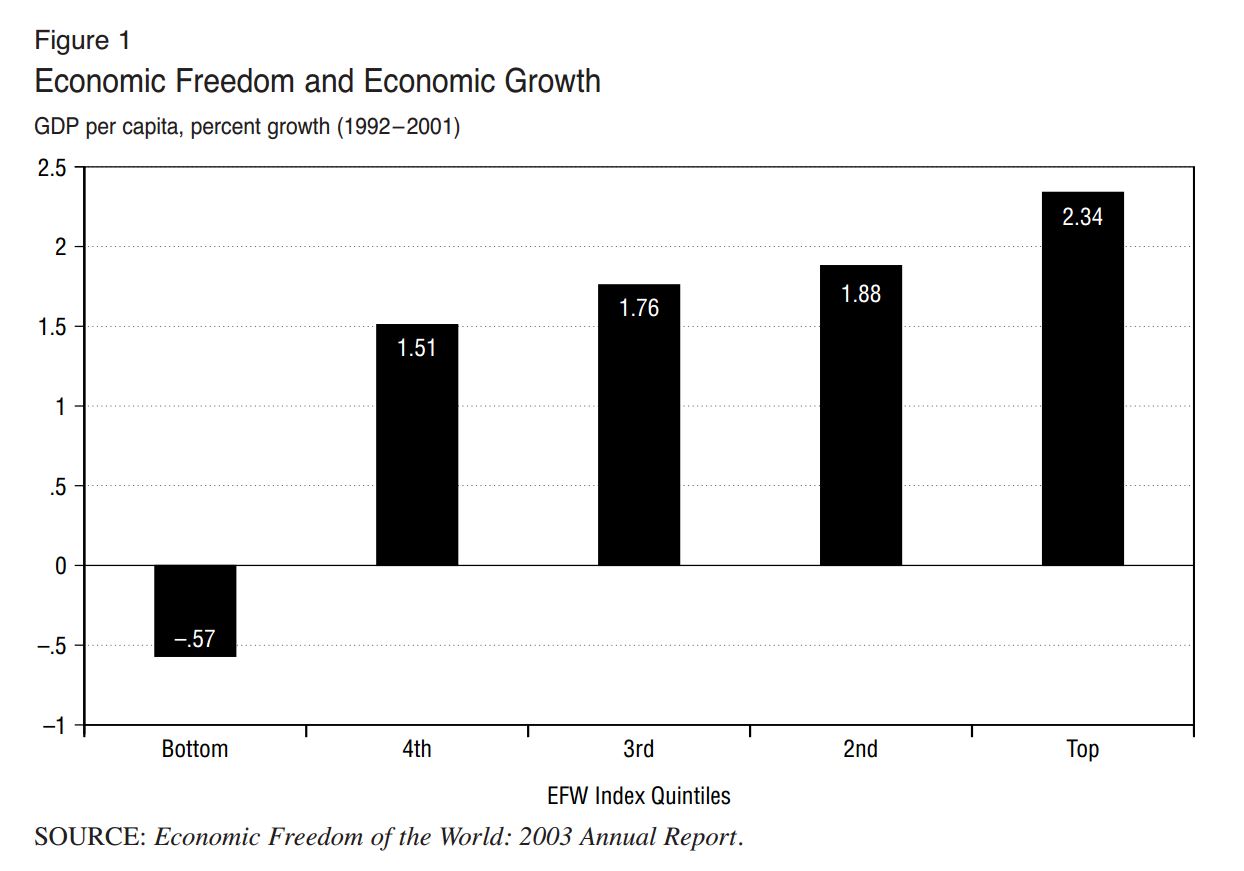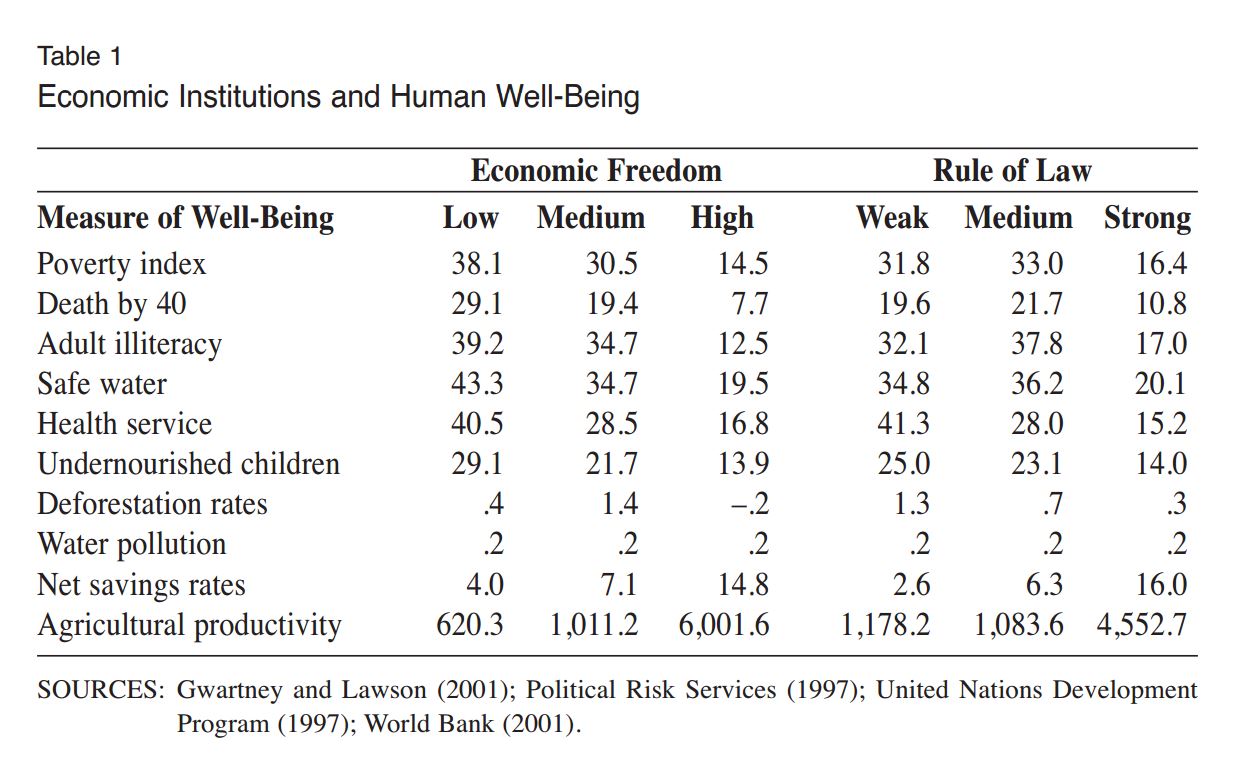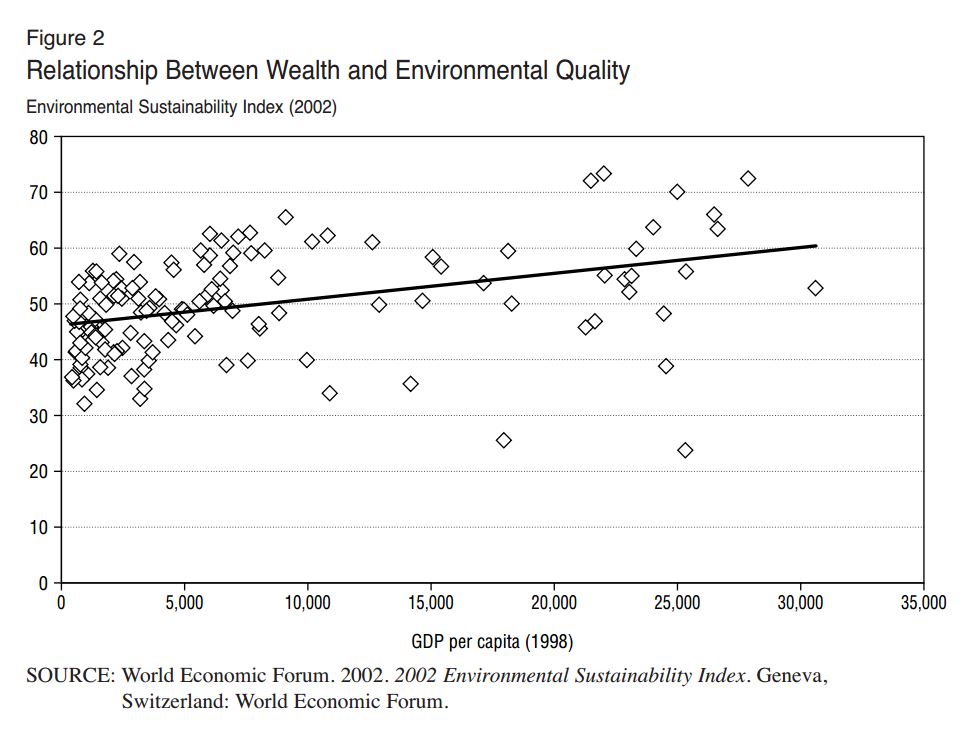Federal Reserve Bank of Dallas
October 23, 2003
“You can’t have a free society without private property.”
– Milton Friedman
By Terry L. Anderson and Laura E. Huggins
Sustainable development has become the byword of environmental policy. The term has been around for about thirty years but has only recently become popular (see International Institute for Sustainable Development 2002). The basic notion is that current consumption of natural resources including air and water for waste disposal is reducing the stock or quality of those resources so that future generations will have less. If it is true that there are finite resource stocks, consumption today will preclude sustained consumption in the future.
In this sense, sustainable development dates back to the eighteenth-century writings of Reverend Thomas Malthus who believed that the decline of living conditions in nineteenth century England was due to the inability of resources to keep up with the rising human population and more recently to the “limits to growth” theory promoted by the Club of Rome in the 1970s. Armed with giant computers, this group predicted precise years when we would reach our limits. Their predictions of disaster for humankind called for regulations restricting natural resource depleting economic and technological progress.
This gloom and doom theory has been resurrected under the guise of sustainable development, calling for changes in virtually every aspect of our consumption and production. Starting in the late 1980s, environmentalists and government officials began using the term “sustainable development” when discussing environmental policy. For example, the seminal United Nations Bruntland Report (1987, 9), claimed that “sustainable development can only be pursued if population size and growth are in harmony with the changing productive potential of the ecosystem.” A paper by the U.S. Department of Housing and Urban Development (1995, 2) declared that “Humanity’s collective imperative now is to shift modern society rapidly onto a sustainable path or have it dissolve of its own ecologically unsustainable doings.”
More recently the interpretations of the term have been broadened to include issues such as poverty, health care, and education. The Johannesburg Declaration on Sustainable Development (2002, 2) stated “that poverty eradication, changing consumption and production patterns, and protecting and managing the natural resource base for economic and social development are overarching objectives of, and essential requirements for sustainable development.”
The term sounds beguilingly simple, but it is vague and operationally vacuous. Sustainable development is most often defined as resource use that meets “the needs of the present without compromising the ability of future generations to meet their own needs”-a definition first offered by the United Nation’s Bruntland Commission. Of course nobody wants to make future generations poorer and less healthy, but this definition provides no guidance for how this result can be avoided. There is no way to know what resource use is acceptable today and no way to know what future generations may desire (see Hayward 2002). Yet because of its deceptive simplicity, sustainability is applied to anything from agricultural practices to energy use to mining. As environmental scientist Timothy O’Riordan stated, “It may only be a matter of time before the metaphor of sustainability becomes so confused as to be meaningless, certainly as a device to straddle the ideological conflicts that pervade contemporary environmentalism” (O’Riordan 1988, 29).
Implicit in the calls for sustainable development are two fundamental assumptions. The first is that we are running out of resources thus leaving future generations with less; the second is that market processes are the cause of these depletions. We challenge both of these assumptions and argue that economic systems based on property rights and the rule of law are the best hope for humanity today to leave an endowment for humanity tomorrow.
For those familiar with the writings of Milton and Rose Friedman, there is nothing new in this conclusion. In Free to Choose, the Friedmans forcefully argued that political and economic freedom are inseparable and that free-market forces work better than government controls for achieving real equality, security, and prosperity.
In this paper, we build on the Friedmans’ case to argue that sustainable development, if it can be defined, is only possible in a legal system where property rights are well-defined, enforced, and transferable. Property rights provide the structure that encourages development, innovation, conservation, and discovery of new resources. Growth and increasing wealth through these mechanisms lead to environmental quality by raising the demand for it and by providing the wherewithal to meet these demands. In this context, economic growth is not the antithesis of sustainable development; it is the essence of it. Therefore, how we deal with the evolution and protection of property rights and the rule of law in the future will not only determine how free and prosperous we are, but also how much environmental quality we enjoy.
The Proven Path to Sustainability
If sustainable development can be defined as a call to maximize human welfare over time, then Adam Smith’s Wealth of Nations could be called “the world’s first blueprint for sustainable development” (Taylor 2002, 29). According to Smith’s blueprint for sustainable development, the wealth of nations depended on market processes guided by the invisible hand which we now understand was not so invisible. Perhaps no one since Adam Smith has so eloquently made it clear that the invisible hand is really property rights and the rule of law as have Milton and Rose Friedman. Institutions such as property rights and the rule of law provide the framework within which people act and interact. They are the rules, customs, norms, and laws that remove the responsibility to calculate the effect of our actions on the rest of humanity and replace it with a responsibility to abide by simple rules that benefit society as a whole. In the words of Richard Epstein, “The government works best when it establishes the rules of the road, not when it seeks to determine the composition of the traffic” (Epstein 1995, xiii).
Sustainable institutions are those that do not prescribe an outcome for society, but allow individuals to improve their own well-being. Truly sustainable institutions provide the freedom for people to improve their world by innovating and developing. The best way to ensure that resources remain for future generations is to directly tie the well-being of people today to those resources-via decentralization and property rights. If individuals have the responsibility of caring for their welfare today, they are more likely to make decisions that will benefit their children, and their children’s children (see Taylor 2003).
Modern data support the conclusion that Adam Smith’s blueprint works. The Fraser Institute’s 2003 Index of Economic Freedom rates and ranks 123 nations based on thirty-eight variables to conclude that the more economically free a country, the greater the level of human development enjoyed by its citizens. The following bar chart helps illustrates the basic notion that economic freedom contributes to a faster growing and more efficient economy, which translates into better and longer lives. “Freeing people economically unleashes individual drive and initiative and puts a nation on the road to economic growth,” says Milton Friedman, one of the original creators of the economic freedom index, “In turn, economic growth and independence from government restrictions promote civil and political liberty” (quoted in Gwartney, Lawson, and Emerick 2003).
These findings are supported by other scholars. Seth Norton, for example, has calculated the statistical relationship between various freedom indexes and environmental improvements. His results show that institutions-especially property rights and the rule of law-are key to human well-being and environmental quality. Norton examined the role of economic institutions on human well-being by dividing a sampling of countries into groups with low, medium, and high economic freedom and the same categories for the rule of law. Table 1 contains the measures of human well-being for the various groups of countries. In all cases except water pollution, countries with low economic freedom are worse off than those in countries with moderate economic freedom, while in all cases those in countries with high economic freedom were better off than those in countries with medium economic freedom. A similar pattern is evident for the rule of law measures (see Norton 2003).
Theodore Panayotou (1997, 465-84) tested five indicators of general institutional quality including: “respect/enforcement of contracts, efficiency of the bureaucracy, efficacy of the rule of law, extent of government corruption, and the risk of appropriation.” He found that higher indexes for the institutional variable led to significant environmental quality improvements. In another study, Madhusudan Bhattarai (2000) found that civil and political liberties, the rule of law, the quality and corruption levels of government, and the security of property rights were important in explaining deforestation rates in sixty-six countries across Latin America, Asia, and Africa. Without question, institutions-especially property rights and the rule of law-are key to environmental improvements (see Anderson 2003).
Policies for sustainable development that prescribe forgoing economic growth in the name of preserving future resources could stall or reverse a proven path of progress. The temptation to impose new layers of government regulation in order to prevent humans from depleting resources for future generations must be pushed aside. Consider the use of whale oil for energy in the nineteenth century. The whale population was unsustainable due to heavy hunting pressures. The near depletion of whales may have threatened the biological diversity of the planet but the loss of whale oil as a resource did not hamper future generations from meeting their needs. More plausibly, according to Steven Hayward (2002, 4), “the use of whale oil facilitated economic development-growing wealth, incomes, occupational specialization, and technological prowess-that put humankind in a position to adopt better, more efficient, more sustainable methods of production.” The demand for whale oil contributed to the development of petroleum and electricity, which were more efficient than whale oil and hence helped restore the whale population.
Growth Unbound
A popular interpretation of sustainable development presumes that environmental degradation is predominantly caused by, and therefore is the responsibility of, rich countries. People in the wealthy world consume a large proportion of the world’s resources and emit too great a proportion of the world’s pollution. Proponents often cling to the beliefs of Dr. Charles Birch (1974, 66), a member of the Club of Rome, who claimed that “the rich must live more simply that the poor may simply live.”
Bjørn Lomborg, author of The Skeptical Environmentalist (2001) set out to prove that resources are becoming more scarce and the environment is getting worse, but instead concluded that almost all environmental indicators are improving primarily because we are wealthier, can afford cleaner technologies, and have more time and money to devote to environmental luxuries. According to Lomborg (2001, 351), “children born today-in both the industrialized world and developing countries-will live longer and be healthier, they will get more food, a better education, a higher standard of living, more leisure time and far more possibilities-without the global environment being destroyed.” Furthermore, Lomborg finds positive correlations between economic growth and environmental quality. He correlates the World Bank’s environmental sustainability index with per capita gross domestic product across 117 nations concluding that “higher income in general is correlated with higher environmental sustainability” (Lomborg 2001, 32).
Similar results came from a recent environmental sustainability index (ESI) developed by the joint effort of the World Economic Forum, the Yale University Center for Environmental Law and Policy, and the Columbia University Center for International Earth Science Information Network. The group measured 142 nations based on twenty indicators and sixty-eight related variables in order to place a sustainability score on each nation. On the ESI scale for 2002, Finland came in first, with a score of 73.9 and Kuwait came in last, with a score of 23.9.
The most significant findings derived from the ESI study compares each nation’s ESI score with its gross domestic product (GDP) per capita and shows that a strong relationship exists between wealth and environmental quality as seen in figure 2. Careful analysis of the figure demonstrates a depiction of what economists call the environmental Kuznets curve, based after Noble laureate Simon Kuznets. At lower levels of income, environmental quality can deteriorate as people trade off environmental quality for economic growth but, as income levels rise, the demand for environmental quality increases at a higher rate (see Yandle, Vijayaraghavan, and Bhattarai 2002).
The work of Indur Goklany adds further optimism to the potential for economic growth to be a major factor in improving environmental quality. In case after case, Goklany demonstrates that economic growth allows the developing world to enjoy higher living standards sooner than the developing world did in the past. For example, once a country such as the United States creates filters for water purification, developing countries do not have to “reinvent the wheel.” They can simply acquire the new technology and improve water quality at lower levels of income (Goklany 2003).
Improvement of the environment with income growth is not automatic but depends on policies and institutions. Economic growth creates the conditions for environmental improvement by raising the demand for improved environmental quality and makes the resources available for supplying it. Whether environmental quality improvements materialize or not, when, and how, depend critically on government policies, social institutions, and the completeness and functioning of markets.
Institutions that promote democratic governments are a prerequisite for sustainable development and enhanced environmental quality. Where democracy dwells, constituencies for environmental protection can afford to exist-without people fearing arrest or prosecution. The democratization of thirty-plus countries in the last twenty-five years has dramatically improved the prospects for environmental protection (Desta 1999).
In the other direction, dictatorships and warlords burden people and environments in many regions of the world such as China and much of Africa. Zimbabwean president Robert Mugabe, for example, has clearly indicated that he has no intention of respecting property rights or the rule of law. His “terror teens” have brutally killed innocent people, and his “land reform” plan demands that more than 20 million of the 23.5 million acres under private ownership be surrendered without compensation. Mugabe’s assault on private property has also taken a toll on wildlife, for without landowners, there is no one to protect them from poachers. Before Mugabe’s attack on private property, Zimbabwe had previously shown the world how to balance economic development with conservation through private and communal ownership. The CAMPFIRE program, for example, championed by the World Wide Fund for Nature, allowed local communities to manage wildlife. Hence wildlife became an asset as villagers in communal areas profited from hunting and photo safaris. Elephant populations mushroomed and poaching plummeted. But Mugabe has duped the poor people of Zimbabwe into thinking that land redistribution without compensation or due process is the key to economic prosperity. In fact, sustainable development will come only from stable property rights. Unless the sanctity of private property can be reestablished in Zimbabwe, its people and its wildlife will continue to suffer.
Environmental degradation does not stem from the actions of the first world but rather from jumbled bureaucratic systems-often the result of well-meaning but misguided intervention. In particular, lack of well-defined and adequately enforceable property rights restricts economic development and stifles entrepreneurial activity in many countries. The Peruvian economist Hernando de Soto (2000) estimates that people in the third world and in ex-communist countries hold more than $9 trillion in what he calls “dead capital”-property that is owned informally, but not legally, and is thus incapable of forming the basis of robust economic development. He advocates the formal recognition of property rights in these countries as an indispensable prerequisite for liberal democracy.
Unsustainable Regulations
The focus on center stage should be on promoting institutions that empower people both politically and economically. These institutions allow people to improve environmental quality indefinitely into the future. This stands in sharp contrast to the undying conclusion of the doomsayers for whom the environment and the plight of human beings will always be worse. Doomsayers continue to profess, as they have since Thomas Malthus, that exponential economic growth and consumption will ultimately run up against resource limits. Paul and Ann Ehrlich (1996, 11) are perhaps the gloomiest.
Humanity is now facing a sort of slow-motion environmental Dunkirk. It remains to be seen whether civilization can avoid the perilous trap it has set for itself. Unlike the troops crowding the beach at Dunkirk, civilization’s fate is in its own hands; no miraculous last-minute rescue is in the cards. . . . even if humanity manages to extricate itself, it is likely that environmental events will be defining ones for our grandchildren’s generation-and those events could dwarf World War II in magnitude.
Those with this mind-set often call for more government regulation to stop growth and curb consumption. For example, Klaus Töpfer (2002, 1), the Executive Director of the United Nations Environment Program (UNEP), hopes to create a “model for international environmental governance.”
Implicit in the definition and use of the term sustainable development is the acceptance that market systems fail to promote sustainability and therefore that command-and-control regulations are necessary to achieve the goal of sustainable development. Agenda 21, for instance, adopted at the 1992 Earth Summit in Rio de Janeiro calls on governments to “create national strategies, plans, and policies” for sustainable development.
The solution offered by those who follow this interpretation is to impose top-down measures such as restrictions on the use of resources, interventions in the behavior of multinational companies, and restrictions on international trade. Yet evidence suggests the contrary.
In 1995, UNEP proposed to restrict and possibly ban twelve chemicals (persistent organic pollutants or “POPs”), including DDT, considered to be damaging to human health and the environment. More recently, The Stockholm Convention (also known as the POPs Treaty) was driven by a network of NGOs and governments who called these chemicals “the dirty dozen.” Because rich countries neither produce nor use any of the twelve, they would not feel the effects of such a ban. The problem is that banning chemicals or technologies, regardless of the risks they impose, does not take into account the risk of not having the technology. People in developing countries are subjected to drinking dirty water and poor sanitation, and they must cope with farming techniques that have not advanced since medieval times.
Man-made chemicals and new technologies can mean the difference between life and death for many people. Some countries such as Belize, Mozambique, and Bolivia have stopped using DDT in their malaria control programs because they fear losing the support of wealthy nations through aid. As a consequence, they have suffered a loss of human life. Several scientists have suggested that the insistence by wealthy nations to ban DDT in malaria-infected countries is a form of eco-colonialism, which may impoverish nations in the same way that imperial colonialism did in the past (Meiners and Morriss 2001). “If we are really concerned with ensuring a cleaner environment and with healthier populations,” writes Richard Tren (2002, Online) ” we should concentrate on ensuring that the developing world can become wealthy. This can be achieved with open markets and liberalized trade, protection of private property and the rule of law.”
If alarmists’ calls are successful, we will have neither sustainable growth nor sustainable improvements in environmental quality. When given responsibility for their lives and property, individuals have generally tended to improve themselves and thus the state of the planet. As Milton and Rose Friedman (1980, 218) explained in Free to Choose, “If we look not at rhetoric but at reality, the air is in general far cleaner and the water safer today than one hundred years ago. The air is much cleaner and the water safer in the advanced countries of the world today than in the backward countries.”
Sustaining Property Rights
It is not resources that are too scarce, but rather the institutions-political and economic systems based on secure property rights and the rule of law-that ensure freedom that are. Jerry Taylor (1993, 10) writes:
The size of our resource pie is determined not by nature but by the social and economic institutions that set the boundaries of technological advance. Closed societies and economies under the heavy hand of central economic planners are doomed to live within the confines of dwindling resource bases and eventually experience the very collapse feared by the conservationists. Liberal societies, built on free markets and open inquiry, create resources and expand the possibilities of mankind.
When the eastern bloc countries were freed from communism, Milton Friedman called for free markets, saying, “Privatize, privatize, privatize.” After more than a decade of experiments trying to create markets, however, he has modified his position, asking: “What does it mean to privatize if you do not have security of property, if you can’t use property as you want to?” (Friedman 2002, xvii). Russia, for example, was able to create a democracy but no rule of law to protect private property. Corruption is prevalent and Russia’s economy has imploded. This does not trivialize its democratization efforts, but rather emphasizes that without the rule of law and protection of property, democracy by itself cannot bring automatic prosperity.
The institution of private property has had more influence than any other policy in the history of the world when it comes to enabling people to escape from poverty. As Tom Bethell (1998, 11) puts it in his book, The Noblest Triumph: Property and Prosperity though the Ages, “Prosperity and property are intimately connected. Exchange is the basic market activity, and when goods are not individually owned, they cannot easily be exchanged.” Because of poorly defined institutions and often corrupt bureaucratic systems, a large proportion of the world’s population is prevented from fully realizing the value of existing property or being able to acquire secure property rights. Hernado de Soto (2000) explained in his recent book, The Mystery of Capital, that the primary problem is that property claims in developing countries, while acknowledged within their communities, often go unrecognized by the government. As a result, these informal owners lack access to the social and economic benefits provided by secure property rights.
When well-defined and enforced property rights are absent, a “tragedy of the commons” situation often prevails. The phrase derives from the incentive to overgraze pastures that are open to all grazers (Hardin 1968). Each potential grazer has an incentive to fatten his livestock on the grass before someone else does. Open access to resources lacks two critical components that property rights systems share-exclusion and governance. Without these two components, people have little incentive to economize on the use of resources. The solution to that problem is to devolve control of resource management to individuals and local bodies, and to ensure that legal institutions support this (see Anderson and Huggins 2003).
A study in Kenya compared the rights and incentives of user groups for forest resource management in the Mt. Elgon National Park, with those of users in the Mt. Elgon Forest Reserve. The authors find that in the Forest Reserve, which represents decentralized management, local community involvement in decision-making, and in rule crafting and enforcement resulted in positive incentives for forest conservation. Forest conditions in the Forest Reserve were found to be better than in the National Park. “The National Park’s policy of forbidding local consumptive use of resources and excluding local populations from making resource-related decisions, engendered animosity and considerable conflicts with the local populations. This created disincentives to local communities that are reflected in the condition of the forest. Decentralized decision-making, in this case, appears to be associated with better forest conservation outcomes” (Mwangi, Ongugo, and Njuguna 2000, 1).
Property rights create the incentive for people to invest in assets and give people possessions against which to borrow so that they might become entrepreneurs. Failure of a country’s legal system to protect property rights will undermine the operation of a market exchange system. If individuals and businesses lack confidence that contracts will be enforced and the fruits of their labor protected, the drive to engage in productive activity declines along with the motivation to protect the environment. “Property rights make the market possible,” said de Soto, commenting on the establishment of property rights in post-totalitarian Iraq. “Once it’s established, the world of credit comes along. It makes investment possible. Because when people invest, they are giving money for a property right. I imagine that the Iraqis are in the same situation of Egypt. Investment is not possible and credit is not possible . . . . So no property rights, no modern Iraq” (Ponnuru 2003, Online).
Furthermore, people need access to economic opportunities. Access to capital and credit, for example, provided under conditions that promote economic opportunities create an avenue for true development. Private savings and loans and government loan programs for farmers and students in the United States presented economic opportunities for low income and working people. In South Asia, the Grameen banks have made capital available to poor people. By creating long-term, low-interest loans, the banks helped generate the wealth people needed to stimulate economic growth (Desta 1999).
Moreover, the institution of private property offers people an incentive to develop new technologies because individuals know they will benefit from investments they make in research and development. Tremendous energy and resources are being applied today to the development of practical substitutes for fossil fuels because the motivation exists to discover lower cost substitutes. For example, brokers are offering cash to farmers who are willing to plant a crop of wind turbines, and farmers are discovering that investing in wind power can be more profitable than raising traditional crops. Large companies are eager to harness the wind. Shell Oil, for example, recently bought its first wind farm in Wyoming. Landowners are also eager to collect wind royalties-especially those who can continue to farm with turbines on their property. As Pat Wood, President Bush’s appointee to the Federal Energy Regulation Commission, observed, “We’ve got lots of wind and it’s about time that people figured out a way to make some money off it” (Huggins 2001, 45).
Julian Simon continually drove home the point that human ingenuity is perpetually responding to impending scarcity by developing alternative technologies that mitigate against that scarcity. The key to mitigating natural resource constraints is to switch on human ingenuity, which allows us to accomplish more with a given amount of resources. The fall of the Berlin Wall and Communism have made it clear that turning on this ingenuity requires getting the incentives right through the appropriate institutions. With property rights and the rule of law in place, economic growth and environmental improvements will follow (see Anderson 2003).
Conclusion
Institutional reform is not free and many countries, for various reasons, resist reform that would improve problems related to human well-being. Perhaps the growing evidence that the protection of private property and growth-enhancing institutions are the building blocks of human well-being will persuade policymakers to reform their established systems (see Norton 2003). Only by upholding political and economic institutions that promote and protect property rights will we be able to sustain development and environmental quality. As the Friedmans put it:
Our society is what we make it. We can shape our institutions. Physical and human characteristics limit the alternatives available to us. But none prevents us, if we will, from building a society that relies primarily on voluntary cooperation to organize both economic and other activity, a society that preserves and expands human freedom, that keeps government in its place, keeping it our servant and not letting it become our master. (Friedman and Friedman, 1980, 37).
It is critical that we focus our efforts on developing and protecting the institutions of freedom rather than on regulating human use of natural resources through political processes. The environment is getting better not worse, and it will continue on this course if human ingenuity can continue to hammer out the institutions of freedom, namely property rights and the rule of law-institutions that will provide the incentive for us to solve whatever environmental problems might come our way.
As we head into the next millennium, it becomes increasingly clear that the progress we have enjoyed is primarily attributable to the freedom of the marketplace and Milton and Rose Friedman have done much to ensure that we have come far on this path. It is important to continue their work by ensuring that the property rights path to sustainable development is made more visible in order to protect the institutions of freedom and the environment at the same time-only then can we have our environmental cake and eat it too!
References
Anderson, Terry L. 2003. The Environment and Property Rights: Recipe for Sustainable Development. Stanford, CA: Hoover Institution Press.
Anderson, Terry L., and Laura E. Huggins. 2003. Property Rights: A Practical Guide to Freedom and Prosperity. Stanford, CA: Hoover Institution Press.
Bethell, Tom. 1998. The Noblest Triumph: Property and Prosperity Through the Ages. New York: St. Martin Press.
Bhattarai, Madhusudan. 2000. “The Environmental Kuznets Curve for Deforestation in Latin America, Africa, and Asia: Macroeconomic and Institutional Perspectives.” Dissertation, Clemson University, Clemson, SC, December.
Birch, Charles. 1976. “Creation, Technology and Human Survival: Called to Replenish the Earth.” The Ecumenical Review, XXVIII, January 1976.
Bruntland, Gro Harlem. 1987. Our Common Future: United Nations World Commission on Environment and Development. Oxford, UK: Oxford University Press.
De Soto, Hernando. 2000. The Mystery of Capital: Why Capitalism Triumphs in the West and Fails Everywhere Else. New York: Basic Books.
Desta, Asayehgn. 1999. “Environmentally Sustainable Economic Development.” Journal of Political Ecology 6: 236.
Driscoll, Jr., Gerald P., Kim R. Holmes and Mary Anastasia O’Grady. 2003. Index of Economic Freedom. Washington, DC: Heritage Foundation and Wall Street Journal.
Ehrlich, Paul R,. and Ann H. Ehrlich. 1996. Betrayal of Science and Reason: How Anti-Environmental Rhetoric Threatens Our Future. Washington, DC: Island Press.
Epstein, Richard. 1995. Simple Rules for a Complex World. Cambridge, MA: Harvard University Press.
Friedman, Milton, and Rose Friedman. 1980. Free to Choose. Orlando, FL: Harcourt, Inc.
Goklany, Indur. 2003. “Economic Growth, Technological Change and Human Well-Being.” In The Environment and Property Rights: Recipe for Sustainable Development, ed. Terry L. Anderson. Stanford, CA: Hoover Institution Press.
Gwartney, James, and Robert Lawson with Neil Emerick. 2003. Economic Freedom of the World: 2003 Annual Report. Vancouver, BC: Fraser Institute.
Hardin, Garrett. 1968. “The Tragedy of the Commons.” Science 162:1243-48.
Hayward, Steven F. 2002. “Making Sense of Sustainable Development.” Brief Analysis No. 422. Dallas, TX: National Center for Policy Analysis.
Huggins, Laura E. 2001. “Wind for Sale.” Weekly Standard October 8, 2001.
International Institute for Sustainable Development. 2002. The Sustainable Development Timeline, 3rd ed. Online: www.iisd.org.
Knox, Anna, and Ruth Meinzen-Dick. 1999. “Property Rights, Collective Action, and Technologies for Natural Resource Management.” CGIAR Systemwide Program on Collective Action and Property Rights, International Food Policy Research Institute, Washington, DC. (Series: Policy Brief, no. 1).
Lomborg, Bjørn. 2001. The Skeptical Environmentalist. New York: Cambridge University Press.
Meiners, Roger E., and Andrew P. Morriss, 2001. “Pesticides and Property Rights.” PERC Policy Series Issue No. PS-22, May. Bozeman, MT: PERC.
Mwangi, Esther, Paul Ongugo, and Jane Njuguna. 2000. “Decentralizing Institutions for Forest Conservation in Kenya: Comparative Analysis of Resource Conservation Outcomes Under National Park and Forest Reserve Regimes in the Mt. Elgon Forest Ecosystem.” Presented at “Constituting the Commons: Crafting Sustainable Commons in the New Millennium” the Eighth Conference of the International Association for the Study of Common Property, Bloomington, Indiana, May 31-June 4.
Norton, Seth. 2003. “Population Growth, Economic Freedom, and the Rule of Law.” In The Environment and Property Rights: Recipe for Sustainable Development, ed. Terry L. Anderson. Stanford, CA: Hoover Institution Press.
O’Riordan, Timothy. 1988. “The Politics of Sustainability.” In Sustainable Environmental Management: Principles and Practice, ed. R. K. Turner. London: Bellhaven Press.
Panayotou, Theodore, 1997. “Demystifying the Environmental Kuznets Curve: Turning a Black Box into a Policy Tool.” In Environment and Development Economics 2: 465-84.
Ponnuru, Romish. 2003. “Who Should Own Iraq?” National Review Online: www.nationalreview.com.
Taylor, Jerry. 1993. “The Growing Abundance of Natural Resources.” In Market Liberalism: A Paradigm for the 21st Century, ed. Ed Crane and David Boaz. Washington, DC: Cato Institute.
Taylor, Jerry. 2002. “Greenback in Jo-burg: The U.N.’s Latest Earth Summit.” National Review, September 16, 2002, 29.
Taylor, Jerry. 2003. “Natural Resources.” Online: http://www.sdnetwork.net/natural_resources.htm.
The Johannesburg Declaration on Sustainable Development: From our Origins to the Future, September 4, 2002.
Tern, Richard. 2002. “The Stockholm Convention: Who Stands to Gain?” International Policy Network, Weekly Comment, 12 July. Online: http://www.policynetwork.net/weekly_comment/richard_tren_july02.htm.
Töpfer, Klaus. 2002. Opening remarks at the sixth session of the Intergovernmental Negotiating Committee for the Stockholm Convention of Persistent Organic Pollutants. Geneva, Switzerland, June 17-21, 2002.
U.S. Department of Housing and Development. 1995. Community Sustainability: Agendas for Choice-Making & Action. Washington, DC.
Yandle, Bruce, Maya Vijayaraghavan, and Madhusudan Bhattarai. 2002. The Environmental Kuznets Curve: A Primer. PERC Research Study RS-02-1. Bozeman, MT: PERC.






